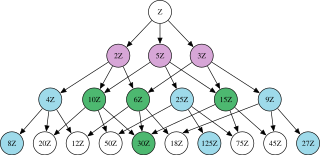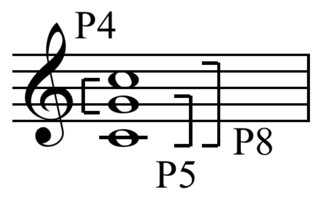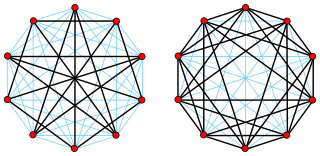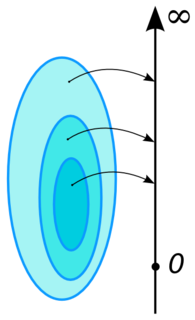
In algebra, a prime ideal is a subset of a ring that shares many important properties of a prime number in the ring of integers. The prime ideals for the integers are the sets that contain all the multiples of a given prime number, together with the zero ideal.
In mathematical analysis and in probability theory, a σ-algebra on a set X is a collection Σ of subsets of X that includes X itself, is closed under complement, and is closed under countable unions.

In the mathematical field of set theory, an ultrafilter on a given partially ordered set (poset) P is a maximal filter on P, that is, a filter on P that cannot be enlarged. Filters and ultrafilters are special subsets of P. If P happens to be a Boolean algebra, each ultrafilter is also a prime filter, and vice versa.
In probability theory, one says that an event happens almost surely if it happens with probability one. In other words, the set of possible exceptions may be non-empty, but it has probability zero. The concept is precisely the same as the concept of "almost everywhere" in measure theory.

Oscar Zariski was a Russian-born American mathematician and one of the most influential algebraic geometers of the 20th century.

In music theory, complement refers to either traditional interval complementation, or the aggregate complementation of twelve-tone and serialism.
In mathematics, a duality, generally speaking, translates concepts, theorems or mathematical structures into other concepts, theorems or structures, in a one-to-one fashion, often by means of an involution operation: if the dual of A is B, then the dual of B is A. Such involutions sometimes have fixed points, so that the dual of A is A itself. For example, Desargues' theorem is self-dual in this sense under the standard duality in projective geometry.

In graph theory, the complement or inverse of a graph G is a graph H on the same vertices such that two distinct vertices of H are adjacent if and only if they are not adjacent in G. That is, to generate the complement of a graph, one fills in all the missing edges required to form a complete graph, and removes all the edges that were previously there. It is not, however, the set complement of the graph; only the edges are complemented.
Czesław Ryll-Nardzewski was a Polish mathematician.
A subset of a topological space has the property of Baire, or is called an almost open set, if it differs from an open set by a meager set; that is, if there is an open set such that is meager. Further, has the Baire property in the restricted sense if for every subset of the intersection has the Baire property relative to .
In computability theory, productive sets and creative sets are types of sets of natural numbers that have important applications in mathematical logic. They are a standard topic in mathematical logic textbooks such as Soare (1987) and Rogers (1987).
In mathematics, the corona theorem is a result about the spectrum of the bounded holomorphic functions on the open unit disc, conjectured by Kakutani (1941) and proved by Lennart Carleson (1962).
Thomas J. Jech is a mathematician specializing in set theory who was at Penn State for more than 25 years.
In mathematics, a pre-measure is a function that is, in some sense, a precursor to a bona fide measure on a given space. Indeed, one of the fundamental theorems in measure theory states that a pre-measure can be extended to a measure.

The Shapley–Folkman lemma is a result in convex geometry with applications in mathematical economics that describes the Minkowski addition of sets in a vector space. Minkowski addition is defined as the addition of the sets' members: for example, adding the set consisting of the integers zero and one to itself yields the set consisting of zero, one, and two:
Convexity is an important topic in economics. In the Arrow–Debreu model of general economic equilibrium, agents have convex budget sets and convex preferences: At equilibrium prices, the budget hyperplane supports the best attainable indifference curve. The profit function is the convex conjugate of the cost function. Convex analysis is the standard tool for analyzing textbook economics. Non‑convex phenomena in economics have been studied with nonsmooth analysis, which generalizes convex analysis.








